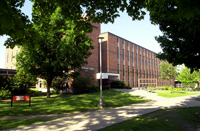UNIVERSITY OF WISCONSIN River Falls
History of Buildings and Areas
Agricultural Science

The agricultural and allied sciences were housed in several campus buildings over the years, but found a home in the new $2,000,000 Agricultural Science building in 1966. The four-story structure included facilities for the sciences that had heretofore been located in North Hall and in the Ag Engineering and Industrial Arts building and a wing of May Hall where food science ovens were housed.
The original building, which provided 20 laboratories along with classrooms and office space, has had several additions from time to time. The first one (engineering addition) added was to the west to accommodate courses taught on construction materials, machine tools and general metals. The first greenhouse was added two years later and in 1979 additional laboratories for welding, electricity and other fields were added. Later a food science wing was constructed for the classes in the processing of various food products.
The cluster of buildings housing the agricultural and allied sciences are known collectively as the Agricultural Science Building and provides instructional space for a staff of approximately 50, offering 16 majors and support courses for other departments. Indeed, as Keith Kolpack wrote in his master’s thesis on the History of the College of Agriculture (1979), the agriculture program at River Falls has “gone far” since its inception in 1912.
The Campus Farm has a longer evolution than that of the agricultural programs. It was Regent P. W. Ramer who is credited with getting the legislature to buy the “Blood Tract” of 14 acres back in 1913. Located on the west end of the campus it was added to from time to time until there was a farm of 100 acres when Professor A. N. Johnson became the first farm manager in 1919. Later the adjacent Pederson farm was added, while the “old Ramer field” was used for residence halls and Rodli Commons. The 293 acre Mann Valley Farm west of River Falls was added after the new complex of agricultural science buildings was completed, providing two separate farms with a total of 440 acres for instructional purpose and research.











